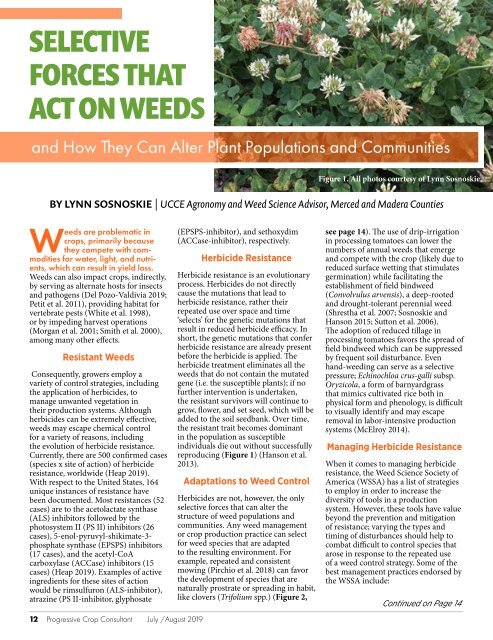Progressive Crop Consultant July/August 2019
Create successful ePaper yourself
Turn your PDF publications into a flip-book with our unique Google optimized e-Paper software.
SELECTIVE<br />
FORCES THAT<br />
ACT ON WEEDS<br />
and How They Can Alter Plant Populations and Communities<br />
Figure 1. All photos courtesy of Lynn Sosnoskie.<br />
BY LYNN SOSNOSKIE | UCCE Agronomy and Weed Science Advisor, Merced and Madera Counties<br />
Weeds are problematic in<br />
crops, primarily because<br />
they compete with commodities<br />
for water, light, and nutrients,<br />
which can result in yield loss.<br />
Weeds can also impact crops, indirectly,<br />
by serving as alternate hosts for insects<br />
and pathogens (Del Pozo-Valdivia <strong>2019</strong>;<br />
Petit et al. 2011), providing habitat for<br />
vertebrate pests (White et al. 1998),<br />
or by impeding harvest operations<br />
(Morgan et al. 2001; Smith et al. 2000),<br />
among many other effects.<br />
Resistant Weeds<br />
Consequently, growers employ a<br />
variety of control strategies, including<br />
the application of herbicides, to<br />
manage unwanted vegetation in<br />
their production systems. Although<br />
herbicides can be extremely effective,<br />
weeds may escape chemical control<br />
for a variety of reasons, including<br />
the evolution of herbicide resistance.<br />
Currently, there are 500 confirmed cases<br />
(species x site of action) of herbicide<br />
resistance, worldwide (Heap <strong>2019</strong>).<br />
With respect to the United States, 164<br />
unique instances of resistance have<br />
been documented. Most resistances (52<br />
cases) are to the acetolactate synthase<br />
(ALS) inhibitors followed by the<br />
photosystem II (PS II) inhibitors (26<br />
cases), 5-enol-pyruvyl-shikimate-3-<br />
phosphate synthase (EPSPS) inhibitors<br />
(17 cases), and the acetyl-CoA<br />
carboxylase (ACCase) inhibitors (15<br />
cases) (Heap <strong>2019</strong>). Examples of active<br />
ingredients for these sites of action<br />
would be rimsulfuron (ALS-inhibitor),<br />
atrazine (PS II-inhibitor, glyphosate<br />
12 <strong>Progressive</strong> <strong>Crop</strong> <strong>Consultant</strong> <strong>July</strong> /<strong>August</strong> <strong>2019</strong><br />
(EPSPS-inhibitor), and sethoxydim<br />
(ACCase-inhibitor), respectively.<br />
Herbicide Resistance<br />
Herbicide resistance is an evolutionary<br />
process. Herbicides do not directly<br />
cause the mutations that lead to<br />
herbicide resistance, rather their<br />
repeated use over space and time<br />
‘selects’ for the genetic mutations that<br />
result in reduced herbicide efficacy. In<br />
short, the genetic mutations that confer<br />
herbicide resistance are already present<br />
before the herbicide is applied. The<br />
herbicide treatment eliminates all the<br />
weeds that do not contain the mutated<br />
gene (i.e. the susceptible plants); if no<br />
further intervention is undertaken,<br />
the resistant survivors will continue to<br />
grow, flower, and set seed, which will be<br />
added to the soil seedbank. Over time,<br />
the resistant trait becomes dominant<br />
in the population as susceptible<br />
individuals die out without successfully<br />
reproducing (Figure 1) (Hanson et al.<br />
2013).<br />
Adaptations to Weed Control<br />
Herbicides are not, however, the only<br />
selective forces that can alter the<br />
structure of weed populations and<br />
communities. Any weed management<br />
or crop production practice can select<br />
for weed species that are adapted<br />
to the resulting environment. For<br />
example, repeated and consistent<br />
mowing (Pirchio et al. 2018) can favor<br />
the development of species that are<br />
naturally prostrate or spreading in habit,<br />
like clovers (Trifolium spp.) (Figure 2,<br />
see page 14). The use of drip-irrigation<br />
in processing tomatoes can lower the<br />
numbers of annual weeds that emerge<br />
and compete with the crop (likely due to<br />
reduced surface wetting that stimulates<br />
germination) while facilitating the<br />
establishment of field bindweed<br />
(Convolvulus arvensis), a deep-rooted<br />
and drought-tolerant perennial weed<br />
(Shrestha et al. 2007; Sosnoskie and<br />
Hanson 2015; Sutton et al. 2006).<br />
The adoption of reduced tillage in<br />
processing tomatoes favors the spread of<br />
field bindweed which can be suppressed<br />
by frequent soil disturbance. Even<br />
hand-weeding can serve as a selective<br />
pressure; Echinochloa crus-galli subsp.<br />
Oryzicola, a form of barnyardgrass<br />
that mimics cultivated rice both in<br />
physical form and phenology, is difficult<br />
to visually identify and may escape<br />
removal in labor-intensive production<br />
systems (McElroy 2014).<br />
Managing Herbicide Resistance<br />
When it comes to managing herbicide<br />
resistance, the Weed Science Society of<br />
America (WSSA) has a list of strategies<br />
to employ in order to increase the<br />
diversity of tools in a production<br />
system. However, these tools have value<br />
beyond the prevention and mitigation<br />
of resistance; varying the types and<br />
timing of disturbances should help to<br />
combat difficult to control species that<br />
arose in response to the repeated use<br />
of a weed control strategy. Some of the<br />
best management practices endorsed by<br />
the WSSA include:<br />
Continued on Page 14


















